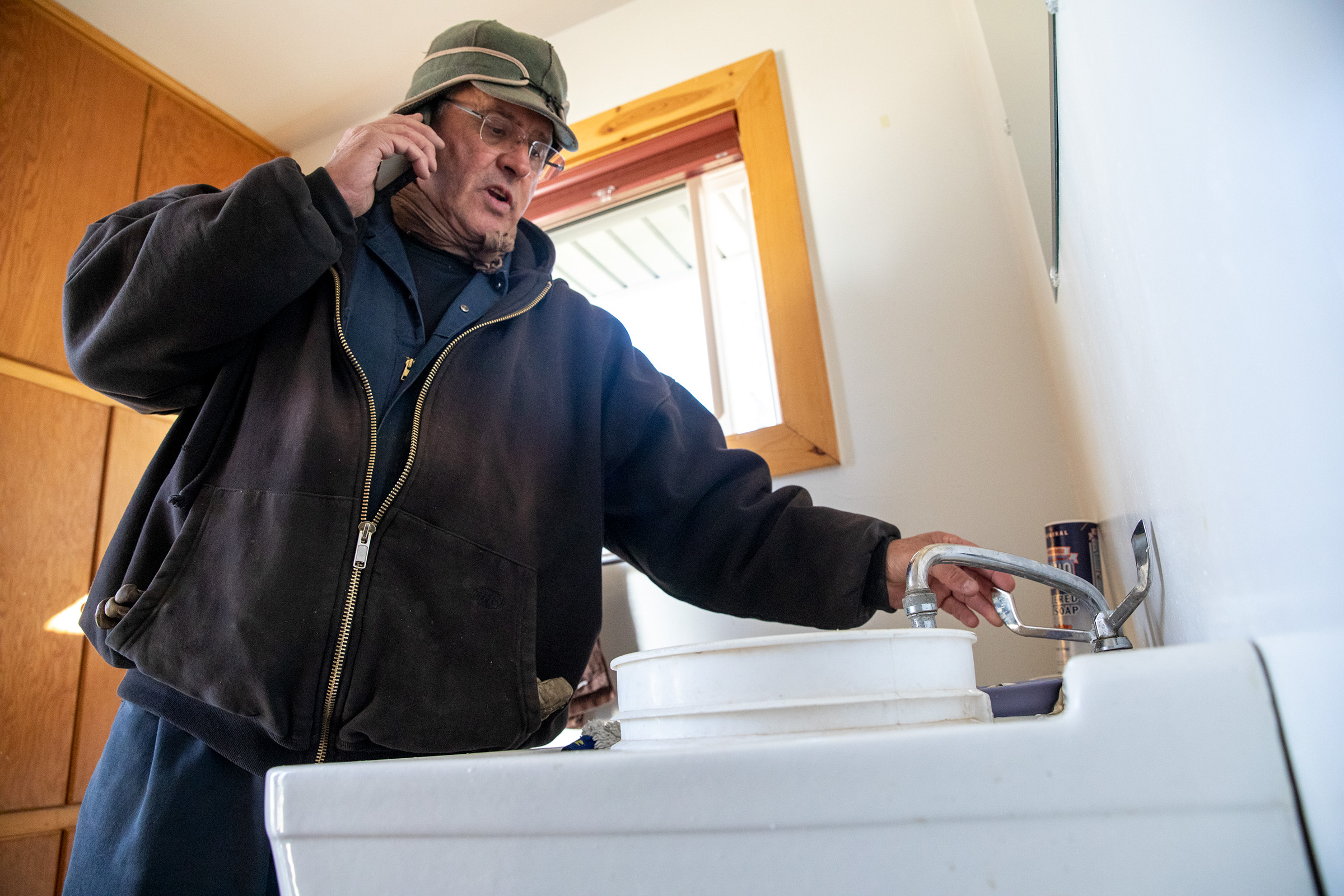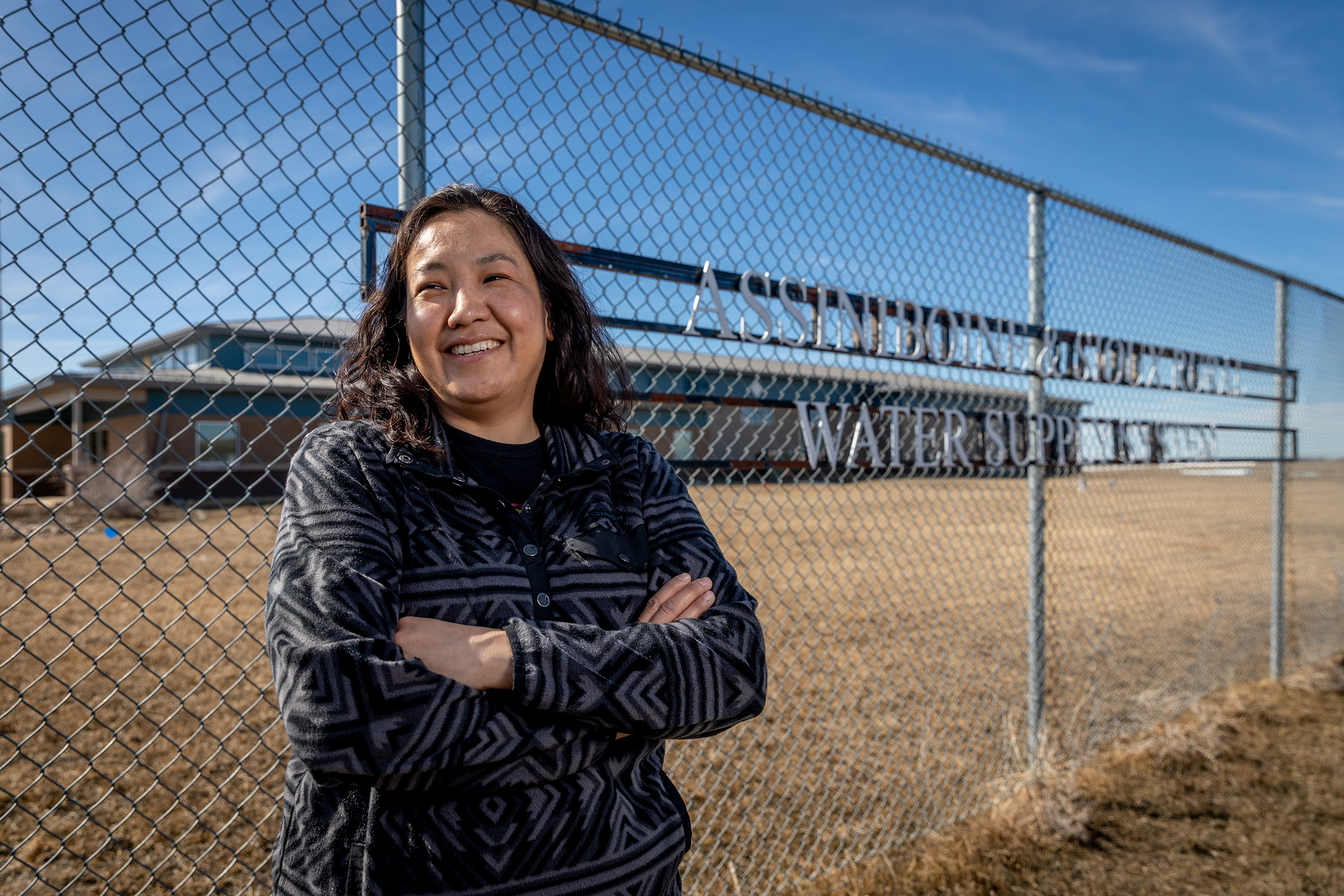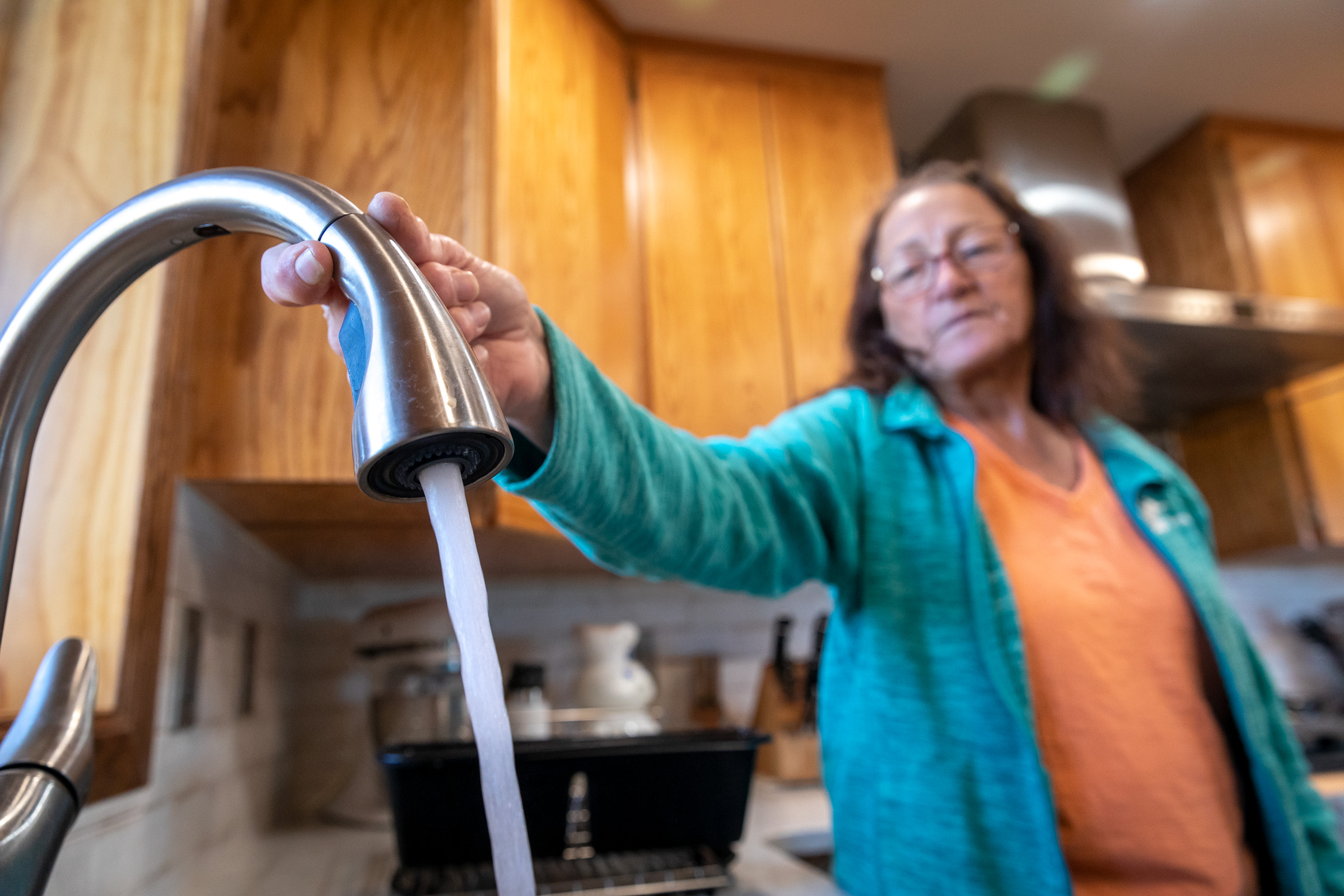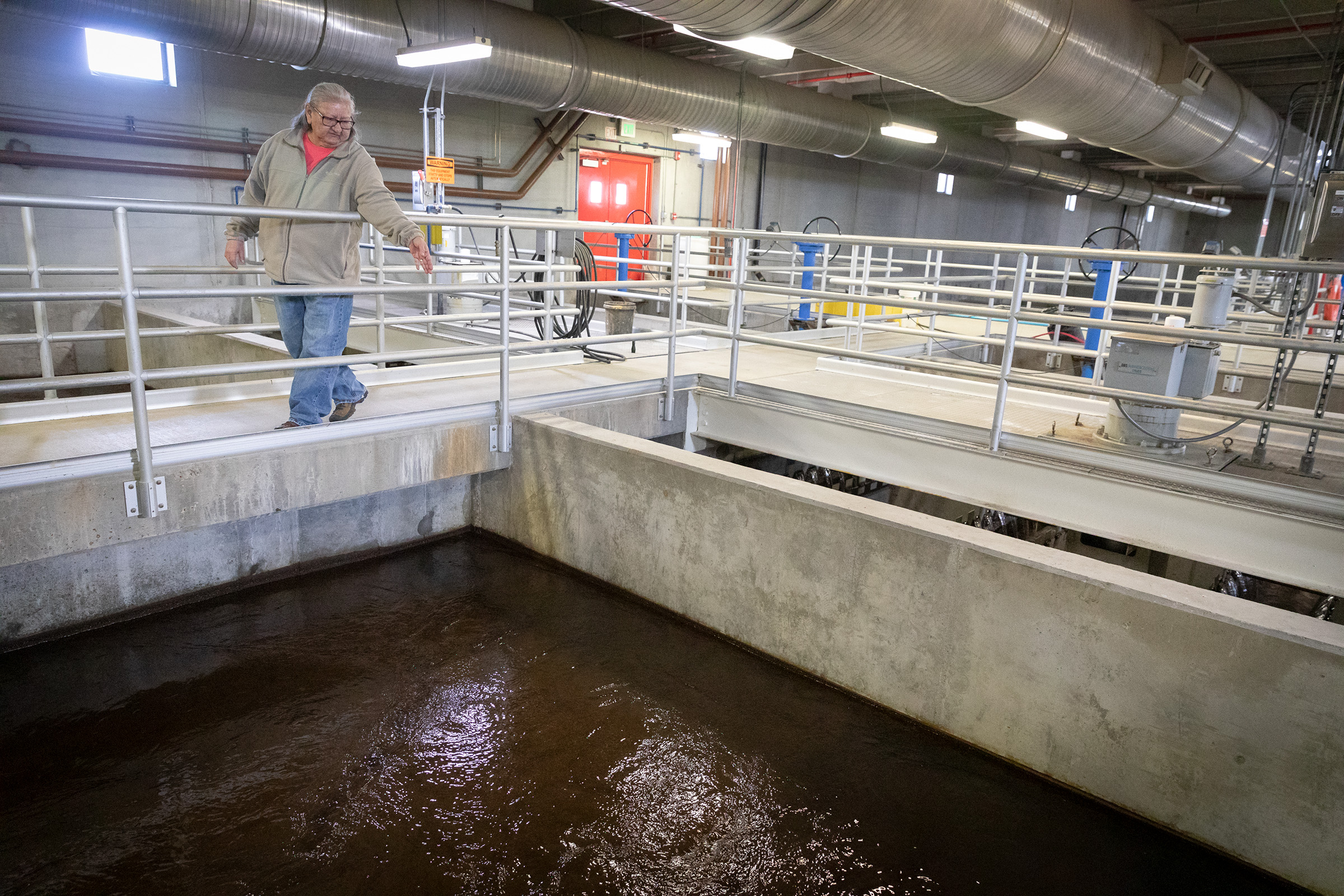
Tapped In
Assiniboine-Sioux project provides relief from water scarcity
Story by Tye Brown, Photos by Antonio Ibarra
Sheet metal clouds swept low, like a veil, over the parched range- lands north of Poplar, Montana. A strong wind followed, kicking up stinging torrents of fine dust. The air chilled. The bitter smell of the drought-stricken prairie lifted, and for a moment there was the promise of a brief spring rain.
But no rain came. The clouds—unbroken, spiteful—moved northeast across the plains, over distant ranches, fields of oil derricks, long abandoned homesteads and dry ponds crosshatched with white alkaline dirt, then dissipated into the blue distance as nondescriptly as they formed.
They passed, too, over Faith and Dun O’Connor’s ranch. Faith, an enrolled member of the Assiniboine, has lived on a 3,000-acre plot 10 miles north of Poplar on the Fort Peck Indian Reservation since 1987 with her husband. In the time they’ve been there, drought conditions have led to a lack of snowpack and rain. United States Geological Survey measurements of research wells in the area show a downward trend in water depth since recording began in 2006.
The Fort Peck reservation, home of the Assiniboine and Sioux tribes, spans more than 2 million acres in the far northeast corner of the state. For most of its history, water accessibility has been a challenge in this region, in particular for farming, ranching and personal use. Recently, worsening drought has made it even harder in the heavily agricultural region.
Faith stands next to her 1975 Ford F-150 looking out into her family’s 3,000 acre drought-stricken land. After years of living on the Fort Peck reservation, Faith can’t remember a time when her family had reliable access to potable water for personal use.
After more than two decades, a water treatment and delivery project is finally nearing completion. Within the next few years, it could provide thousands of households, ranches and farms with clean water. Residents hope this will mark the end of water insecurity that has made it difficult to live in the area.
According to the Montana Climate Office, Roosevelt and Valley Counties, which lie in the Fort Peck reservation, are in an area of extreme drought that will remain unchanged through 2022, resulting in major pasture losses and widespread water shortages.
What groundwater remains on the Missouri River watershed, which runs just south of Poplar, is either naturally contaminated with high amounts of iron, manganate and other minerals, or is polluted by an underground oil brine plume resulting from years of drilling.
Parts of the Murphy Oil fields can be seen just across the Poplar River from the O’Connor property. White storage tanks rise out of the prairie like a taunt, a stark reminder of the environmental disaster poisoning their lifeblood.

“All of the trees here are dying, on the river all along the bottoms,” Faith said. For as long as she can remember, she couldn’t have houseplants. The water would wither them. Near her house, Badger Creek once flowed through a marshy coulee dense with cottonwoods. Now, the trees are skeletons and the ground is desiccated.
Having lived on the reservation her entire life, Faith can’t recall a time until the last few years when her family has had reliable access to potable water for their personal use. Drinking, washing dishes and clothes, and showering have all been challenging.
Then, in 2019, the O’Connors were eager to be tapped into the Assiniboine & Sioux Rural Water Supply System, which now provides their household with clear, clean water. A network of nearly 3,200 miles of pipes, the water system, processed through the Wambdi Wahachanka Water Treatment Facility near Wolf Point, delivers treated, potable water from the Missouri River to rural homeowners east and west along U.S. Highway 2, and all the way to the reservation’s northern border some 40 miles away.
***
The rural water system is entering its 20th year of construction. Since initial funding for the project was approved by Congress in 2001, it has been built incrementally alongside the Dry Prairie Rural Water System, the project’s off-reservation section servicing areas in Valley, Daniels and Sheridan Counties. After two decades, the historic water problems on the Fort Peck reservation could be solved.
Every year, the window for construction is tight. Often, the ground doesn’t thaw thoroughly enough until late spring to dig the seven feet needed for piping, and recently, early cold fronts intensified by climate change have halted progress earlier in the year.
Now, the system is nearly finished. Mike Watson, head engineer of the project since its beginning, estimates the on-reservation section to be about 90% complete. If construction goes according to schedule, Watson said, every main line and branch connection should be tapped in by 2023 or 2024. According to Watson, a project of such magnitude had an estimated 20 year timeline since its inception, with a few buffer years on either side to account for speedy or halted construction.
Deb Madison, director of the Fort Peck Tribes mineral office, looks out over the frozen waters of the Missouri River near Wolf Point. Madison worked for the tribe’s office of environmental protection from 1987 until 2017, looking into the state of water quality and drought on the reservation. “Drought has been an issue since the 80s, and It’s going to get worse,” she said. “There are still so many unknowns. I hope the tribe is ready for the challenges because it’s coming.”
As a child, Faith can remember her iron heavy well water running a burnt orange color before it ran dry entirely. She now has a 12-foot deep well next to her yard that has also gone dry. The handful of livestock wells on her shared rangeland 20 miles north, each between 100 and 200 feet deep, are also dry. A single gravity spring near the remains of Badger Creek was the sole source of relatively clean water on her property for years.
“My opinion on the water system, that’s God’s gift. And that ain’t no bullshit,” said Dun O’Connor. “Groundwater is getting worse up here. It was polluted by the oil, and probably other things, too. But that water system, that’s God’s gift.”
The O’Connors are among the fortunate. A patchwork of properties near them already have the infrastructure laid under their land, but remain unconnected. North of Wolf Point, another string of rural residents are still waiting for the water. Around Lustre, Montana—an unincorporated reservation community about 35 miles north of Highway 2—decades of poor farming practices have caused unsafe levels of nitrogen to seep into a shallow aquifer, according to Deb Madison, director of the Fort Peck Tribes mineral office. Some in that area are also unconnected.
“The health effects are detrimental to babies that had nitrate laced milk formula,” Madison said. High levels of nitrates in water can lead to infant methemoglobinemia, or blue baby syndrome, which causes an infant’s skin to turn blue from lack of oxygen.
“People don’t drink enough water,” Madison said. Around the reservation, she said, “Water is just not a resource that’s depended on for anything except maybe flushing your toilet and taking a quick shower.”
1. A truck drives past a section of arid ranch land north of Poplar and Highway. The Fort Peck reservation has long battled the effects of climate change, particularly drought, groundwater availability and contamination from natural and human causes. Estimates show groundwater will continue to decline. 2. Faith drives past the skeletons of dead cottonwood trees along Badger Creek on her property north of Poplar.
Once the final connection is made, both the tribal system and the Dry Prairie system will service a total population of around 24,000, according to the water system office. This includes treated water running through city systems on the reservation in Poplar, Wolf Point, Brockton and other communities, as well as towns off the reservation. On the reservation, the water system will provide water to nearly the entire population of more than 10,400, save those in rural areas who choose to remain unconnected.
The rural water system is financed by both state funding and directly from Congress, which renews the budget annually. For fiscal year 2022, the budget requested is $3.3 million.
The U.S. Bureau of Reclamation, the federal agency which oversees water resources management, then completes annual indexing on predicted expenses before determining how much money is allotted to the tribal government. From there, the tribes bid for contractors to pick up the construction.
Ryan Newman, area manager of the Montana reclamation office, said project indexing for 2022 has been a challenge due to a recent spike in the price of construction material. “We adjust for inflation from year to year, and definitely the increase in material pricing over this last year has resulted in us having to take a deeper dive into how we go in and make those adjustments,” Newman said.
“We’re not stalled or delayed,” he added. “But we definitely are going back through and working through the numbers.”
The bureaucracy involved has led to mounting frustration for those still waiting to take advantage of the system. Noah Strauser lives just north of the O’Connor ranch. The pipes needed to connect his house to the rural water supply were laid under his yard last year, but he’s yet to receive any water.
The groundwater under Strauser’s property has caused significant harm to his plumbing. In the last couple years, he said, he’s had to replace his kitchen faucet half a dozen times due to corrosion. Water softeners have barely been able to mitigate the damage.
Strauser says he expects his residence to be connected by fall, but until that connection is made, he continues to buy his family’s drinking water in bottles and gallon jugs. With a virtually unlimited amount of clean water so close, the financial frustrations of purchasing water and replacing pipes are amplified.
***
Ashleigh Weeks, project manager of the rural water system, spends her workdays at the water system office in Poplar addressing these concerns with individuals, coordinating with contractors, scheduling repair work and pressure tests along branch lines, and working with the Wambdi Wahachanka Water Treatment Facility.
“I hear about a lot of people wanting to move home, moving back to their old farmsteads, putting in new homes because they can get good water now,” Weeks said. “I think it has prevented so much economic expansion in a lot of areas because we didn’t have the water.”



Weeks was raised just east of Poplar, directly above the oil brine plume. Her personal memories of poor water quality growing up are shared by many from that area. “We had to haul water for drinking. We were constantly buying the smaller individual packs. And we’d drink a lot of pop,” she said. “A lot of people have that story, that we grew up on pop, because that’s all we had.”
After graduating from Montana State University in 2011 with a degree in civil engineering, Weeks returned to Poplar and moved back into her childhood house once her father relocated to town. She worked for the tribes’ environmental office until 2019, when she took her current position.
“I just wanted to use my degree to help,” Weeks said. “It really feels fulfilling working for this organization, to see all the good that it does for the area.”
In 2016, Weeks’s residence was finally tapped into the system. She still remembers struggling with water issues as she started to raise her own family. She said her water often came out of the tap the color of rust.
“When I first moved home after college, I had a baby,” Weeks said. “I tried to fill a little tiny baby tub full of water, and it was probably six inches, and you couldn’t even see the bottom. It was like, I can’t put my baby in this.” Like Strauser, Weeks bought all of her water in town.
Construction of the rural water supply system is split into four phases. The first phase—covering the land east of the Poplar River to the reservation border, all along U.S. Highway 2 and areas around Montana Highway 250 to Lustre—are finished. The next three, covering a smaller combined area, are still under construction. The main lines are all in place, but they still need smaller branch connections to individual houses.
“It’s the biggest thing we have in this area. I mean, there’s nothing else of that magnitude or any type of engineering feat like that,” Weeks said. “Through the plant and the entire distribution system, we’re providing water to pretty much all of northeastern Montana.”
***
The nucleus of the project is the Wambdi Wahachanka Water Treatment Facility, located about four miles north of the Missouri River intake. Weeks joked that the large brick building reminds her of a prison. It’s an isolated structure flanked by barbed wired chain-link tucked beneath a patch of low hills. Travelers along the highway might find it unassuming. It almost blends into the topography. The backbone of the entire system carries out its essential day-to-day operations without pronouncement.
Through a complex network of pumps, tanks, filters and chemical injections, the plant has the capacity to treat millions of gallons of water per day de- pending on regional demand. In July, 2021, the plant saw a record production of 172 million gallons for one month, said plant manager Sandra White Eagle.





Rangeland fires exacerbated by worsening drought are leading to a much higher demand for water, which needs to be diverted by plant operators from residences to the hydrants used by rural volunteer firefighters.
“When the fire situation was happening last summer, we really tried to keep everybody accessible to water, but that was kind of an issue,” White Eagle said. Managing pressure and flow through branch lines during fast moving emergencies like range fires is a challenge. “When they have a fire they’ll call us, we can make sure there’s enough pressure.”
The Wambdi Wahachanka Water Treatment Facility was dedicated in 2012. It bears the Indigenous name, Eagle Shield, of former tribal chairman Dr. Caleb Shields. The preservation of natural resources, water in particular, was a major goal of his tenure from 1991-1999. Shields died at 83 on the first day of 2022.




Bill Whitehead, chairman of the Assiniboine & Sioux Rural Water Supply System, was a friend and close associate of Shields. Whitehead, too, has spent five decades working with the state and federal governments to preserve Fort Peck’s access to water. Also a former chairman of the tribes, Whitehead used his clout to lobby Congress for initial funding for the project. In 2019, he denounced the Keystone XL pipeline’s proposed construction beneath the confluence of the Missouri and Milk Rivers, immediately upstream of the tribal border and water intake.
“Our whole identity is the land, the water, the air. That’s part of who we are. It’s our responsibility in terms of treaty rights and seven generations,” Whitehead said, referring to the seven generations principle. The principle states that decisions made today should be done so with the goal of sustainability seven generations into the future. It’s a philosophy of generational stewardship Whitehead thinks is essential when discussing natural resources and climate change, especially as drought conditions dramatically worsen.
This year, the Fort Peck Tribes Water Resources Office updated work for its drought mitigation plan. The plan, originally written in 2005, was amended to analyze more recent data of drought stages, indicators and impacts. It also proposes eight new drought monitoring stations across the reservation set up in conjunction with the Army Corps of Engineers, ac- cording to Arnie Bighorn, the tribes director of water rights.
***
1. Dun O’Connor sits on horseback as he prepares for the day’s ranch duties at their home north of Poplar. Since 1987, the O’Connors have lived on a 3,000-acre property where they farm and ranch. During that time, they have experienced drier than normal conditions and a lack of surface and underground water. 2. Grain silos seen through the window of an abandoned ranch house north of Highway 2 outside Poplar. Through the years, many Fort Peck residents said families had to leave their rural homes due to intense drought conditions for places closer to the Missouri River’s water.
Early in the morning on the O’Connor’s ranch, Faith took a moment away from breakfast to take her pickup for a lap around her property. She wove the truck through a stand of bare cottonwoods, across the dry remnants of Badger Creek and remarked on a dead thicket of juneberry bushes near her gravity spring.
“It was just two years ago. Now look at all the dead stuff,” she said. “It used to be so thick in here you couldn’t see.” Faith said in the spring, the marshy creek bottom used to reliably sink a vehicle in a foot of mud. Now, her vehicle kicks up a trail of dust as she drives along a fresh two-track path.
Drought data for research and development purposes can’t tell the O’Connors anything they haven’t experienced directly for years. They fear that as de- mand for water through the rural water system continues to rise, their free commodity may eventually begin to cost them.
Returning home, Faith parked her pickup by the meter pit in her yard. It was still early in the morning. “If there’s limited resources, you’re going to have to pay,” she said. “And water’s going to be one of the most expensive things, because you have to have water.”
She poured a cup of coffee, filled a glass to water a plant on her windowsill and washed her hands. “If I have to pay for it, fine. At least I’d have it,” she said. “If push comes to shove, I’d rather have water than anything else.”
A SPECIAL PROJECT BY THE UNIVERSITY OF MONTANA SCHOOL OF JOURNALISM
ADDITIONAL FUNDING SUPPORT FROM THE GREATER MONTANA FOUNDATION
READ MORE:

Previous